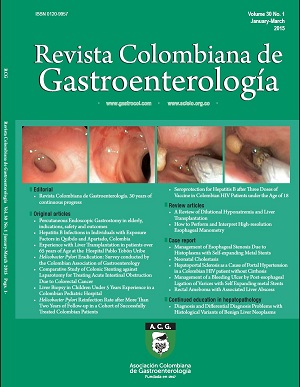Diagnosis and Differential Diagnosis Problems with Histological Variants of Benign Liver Neoplasms
DOI:
https://doi.org/10.22516/25007440.31Keywords:
Benign liver tumors adenoma, focal nodular hyperplasia, nodular regenerative hyperplasia, hemangioma, angiomyolipoma, hamartoma, biliary hamartoma, mesenchymal hamartoma, von Meyenberg complexes, simple cysts, mucinous neoplasms, biliary cystadenomaAbstract
A basic principle of pathology is that neoplasms differ according to their cells of origin. Neoplasms of the liver resemble its constituent liver, biliary, epithelial, endothelial, mesenchymal cells or some combination of these
different types of cells. It is important to remember here that metastases are the most frequent malignant liver tumor occurring at ratio of 30: 1 in patients without underlying chronic liver disease or cirrhosis. Metastases are rare in cirrhotic livers. The most common primary sites are the colon, pancreas, common bile duct, stomach, neuroendocrine tumors and GIST, or extraintestinal tumors from the lung, breast, head, neck and skin (1). In this article we review only the most frequent benign neoplasms and tumor-like lesions with particular emphasis on diagnostic difficulties, special studies, and the usefulness of immunohistochemical or molecular studies for proper classification and differential diagnosis.
Downloads
References
Goodman ZD. Neoplasms of the liver. Mod Pathol Off J U S Can Acad Pathol Inc 2007;20(Suppl 1):S49-60.
Paradis V. Benign liver tumors: an update. Clin Liver Dis 2010;14(4):719-29.
Greaves WOC, Bhattacharya B. Hepatic adenomatosis. Arch Pathol Lab Med 2008;132(12):1951-5.
Lizardi-Cervera J, Cuéllar-Gamboa L, Motola-Kuba D. Focal nodular hyperplasia and hepatic adenoma: a review. Ann Hepatol 2006;5(3):206-11.
Dhingra S, Fiel MI. Update on the new classification of hepatic adenomas: clinical, molecular, and pathologic cha- racteristics. Arch Pathol Lab Med 2014;138(8):1090-7.
Joseph NM, Ferrell LD, Jain D, Torbenson MS, Wu T-T, Yeh MM, et al. Diagnostic utility and limitations of glutamine synthetase and serum amyloid-associated protein immuno- histochemistry in the distinction of focal nodular hyperpla- sia and inflammatory hepatocellular adenoma. Mod Pathol Off J U S Can Acad Pathol Inc 2014;27(1):62-72.
Rebouissou S, Bioulac-Sage P, Zucman-Rossi J. Molecular pathogenesis of focal nodular hyperplasia and hepatocellu- lar adenoma. J Hepatol 2008;48(1):163-70.
Makhlouf HR, Abdul-Al HM, Goodman ZD. Diagnosis of focal nodular hyperplasia of the liver by needle biopsy. Hum Pathol 2005;36(11):1210-6.
Al-Mukhaizeem KA, Rosenberg A, Sherker AH. Nodular regenerative hyperplasia of the liver: an under-recognized cause of portal hypertension in hematological disorders. Am J Hematol 2004;75(4):225-30.
López R, Barrera L, Vera A, Andrade R. Concurrent liver hodgkin lymphoma and nodular regenerative hyperplasia on an explanted liver with clinical diagnosis of alcoholic cirr- hosis at University Hospital Fundación Santa Fe de Bogotá. Case Rep Pathol 2014;2014:193802.
Hsi Dickie B, Fishman SJ, Azizkhan RG. Hepatic vascular tumors. Semin Pediatr Surg 2014;23(4):168-72.
Mo JQ, Dimashkieh HH, Bove KE. GLUT1 endothelial reactivity distinguishes hepatic infantile hemangioma from congenital hepatic vascular malformation with associated capillary proliferation. Hum Pathol 2004;35(2):200-9.
Lo RC. Epithelioid angiomyolipoma of the liver: a cli- nicopathologic study of 5 cases. Ann Diagn Pathol 2013;17(5):412-5.
Nonomura A, Enomoto Y, Takeda M, Takano M, Morita K, Kasai T. Angiomyolipoma of the liver: a reappraisal of mor- phological features and delineation of new characteristic histological features from the clinicopathological findings of 55 tumours in 47 patients. Histopathology 2012;61(5):863-80. 15. Bailador Andrés MC, Vivas Alegre S, Rueda Castañón R. Multiple bile-duct hamartomas (Von Meyemburg com- plexes). Rev Esp Enfermedades Dig Organo Of Soc Esp Patol Dig 2006;98(4):306-7.
Stringer MD, Alizai NK. Mesenchymal hamartoma of the liver:
a systematic review. J Pediatr Surg 2005;40(11):1681-90.
Fretzayas A, Moustaki M, Kitsiou S, Nychtari G, Alexopoulou E. Long-term follow-up of a multifocal hepatic mesenchymal hamartoma producing a-fetoprotein. Pediatr Surg Int 2009;25(4):381-4.
Soares KC, Arnaoutakis DJ, Kamel I, Anders R, Adams
RB, Bauer TW, et al. Cystic neoplasms of the liver: biliary cystadenoma and cystadenocarcinoma. J Am Coll Surg 2014;218(1):119-28.
Michael Torbenson. Biopsy Interpretation of the liver. 2014.
Hernandez Bartolome MA, Fuerte Ruiz S, Manzanedo Romero I, Ramos Lojo B, Rodriguez Prieto I, Gimenez Alvira L, et al. Biliary cystadenoma. World J Gastroenterol WJG 2009;15(28):3573-5.
Tsepelaki Α, Kirkilesis I, Katsiva V, Triantafillidis JK,
Vagianos C. Biliary cystadenoma of the liver: case report and systematic review of the literature. Ann Gastroenterol 2009;22(4):278-83.
Zen Y, Pedica F, Patcha VR, Capelli P, Zamboni G, Casaril A, et al. Mucinous cystic neoplasms of the liver: a clinicopatho- logical study and comparison with intraductal papillary neoplasms of the bile duct. Mod Pathol Off J U S Can Acad Pathol Inc 2011;24(8):1079-89.
Li T, Ji Y, Zhi X-T, Wang L, Yang X-R, Shi G-M, et al. A com- parison of hepatic mucinous cystic neoplasms with biliary intraductal papillary neoplasms. Clin Gastroenterol Hepatol Off Clin Pract J Am Gastroenterol Assoc 2009;7(5):586-93.
Downloads
Published
How to Cite
Issue
Section
License
Aquellos autores/as que tengan publicaciones con esta revista, aceptan los términos siguientes:
Los autores/as ceden sus derechos de autor y garantizarán a la revista el derecho de primera publicación de su obra, el cuál estará simultáneamente sujeto a la Licencia de reconocimiento de Creative Commons que permite a terceros compartir la obra siempre que se indique su autor y su primera publicación en esta revista.
Los contenidos están protegidos bajo una licencia de Creative Commons Reconocimiento-NoComercial-SinObraDerivada 4.0 Internacional.




















